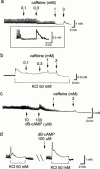The properties of ryanodine-sensitive Ca(2+) release in mouse gastric smooth muscle cells
- PMID: 11325802
- PMCID: PMC1572764
- DOI: 10.1038/sj.bjp.0704048
The properties of ryanodine-sensitive Ca(2+) release in mouse gastric smooth muscle cells
Abstract
1. Under voltage-clamped conditions, gastric smooth muscle cells of BALB/c mice developed spontaneous (STOCs) and caffeine- (I(CAF)) and carbachol-induced (I(CCh)) transient outward currents. 2. In fura-2 microscopic measurements of intracellular Ca(2+) concentration ([Ca(2+)](i)), caffeine and carbachol (CCh) provoked similar transient [Ca(2+)](i) elevations. 3. Both I(CCh) and CCh-induced [Ca(2+)](i) elevation of single smooth muscle cells occurred in an 'all-or-nothing' fashion in contrast to the reproducible caffeine responses. 4. On the basis of the suppression of STOCs and I(CAF) by nicardipine, tetraethylammonium and iberiotoxin, but not by charybdotoxin nor apamin, it was suggested that both currents were generated by large conductance type Ca(2+)-activated K(+) channels. 5. In measurements of isometric tension, caffeine produced relaxation of gastric smooth muscle strips in a concentration-dependent manner (0.1 -- 3 mM). The concentration-dependent relaxation with caffeine was mimicked by dibutyryl cyclic AMP which produced potentiation of contraction triggered by 50 mM KCL. 6. At caffeine concentrations >3 mM, a transient contraction followed by relaxation was provoked as the quasi maximal response to caffeine. In the quasi maximal response, caffeine acted as a potent relaxant in smooth muscle strips precontracted with 50 mM KCl or 3 microM CCh. 7. The relaxation with caffeine was significantly accelerated in those strips precontracted with KCl or CCh. All these results suggest that ryanodine-sensitive Ca(2+) release, which is triggered by caffeine, is an important modifier of Ca(2+) homeostasis in the cytoplasm and the contractility of gastric smooth muscle cells of mice.
Figures








Similar articles
-
Nitrergic relaxation of the mouse gastric fundus is mediated by cyclic GMP-dependent and ryanodine-sensitive mechanisms.Br J Pharmacol. 2000 Apr;129(7):1315-22. doi: 10.1038/sj.bjp.0703174. Br J Pharmacol. 2000. PMID: 10742286 Free PMC article.
-
The inhibitory action of cyclic AMP on responses to carbachol dependent on calcium stores in rat gastric smooth muscle.J Physiol. 1992;453:367-84. doi: 10.1113/jphysiol.1992.sp019233. J Physiol. 1992. PMID: 1334513 Free PMC article.
-
Inhibitory effects of dantrolene on contractile responses in gastric smooth muscle of the rat.J Vet Med Sci. 1994 Apr;56(2):275-9. doi: 10.1292/jvms.56.275. J Vet Med Sci. 1994. PMID: 8075215
-
Nonselective cation channels activated by the stimulation of muscarinic receptors in mammalian gastric smooth muscle.J Smooth Muscle Res. 2003 Dec;39(6):231-47. doi: 10.1540/jsmr.39.231. J Smooth Muscle Res. 2003. PMID: 15048016 Review.
-
Spontaneous transient outward currents in smooth muscle cells.Cell Calcium. 1996 Aug;20(2):141-52. doi: 10.1016/s0143-4160(96)90103-7. Cell Calcium. 1996. PMID: 8889205 Review.
Cited by
-
Regulation of gastrointestinal motility by Ca2+/calmodulin-stimulated protein kinase II.Arch Biochem Biophys. 2011 Jun 15;510(2):174-81. doi: 10.1016/j.abb.2011.03.009. Epub 2011 Apr 3. Arch Biochem Biophys. 2011. PMID: 21443856 Free PMC article. Review.
-
Evaluation of the Effects of Instant Cascara Beverage on the Brain-Gut Axis of Healthy Male and Female Rats.Nutrients. 2023 Dec 25;16(1):65. doi: 10.3390/nu16010065. Nutrients. 2023. PMID: 38201895 Free PMC article.
-
Ex Vivo Study of Colon Health, Contractility and Innervation in Male and Female Rats after Regular Exposure to Instant Cascara Beverage.Foods. 2024 Aug 6;13(16):2474. doi: 10.3390/foods13162474. Foods. 2024. PMID: 39200401 Free PMC article.
-
Mechanistic Study of Coffee Effects on Gut Microbiota and Motility in Rats.Nutrients. 2022 Nov 18;14(22):4877. doi: 10.3390/nu14224877. Nutrients. 2022. PMID: 36432563 Free PMC article.
-
Caffeine impairs gastrointestinal function in newborn rats.Pediatr Res. 2015 Jul;78(1):24-8. doi: 10.1038/pr.2015.65. Epub 2015 Mar 25. Pediatr Res. 2015. PMID: 25806715
References
Publication types
MeSH terms
Substances
LinkOut - more resources
Full Text Sources
Medical
Miscellaneous

